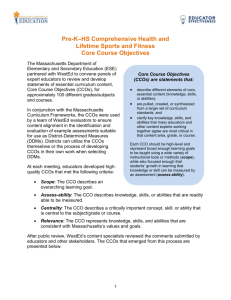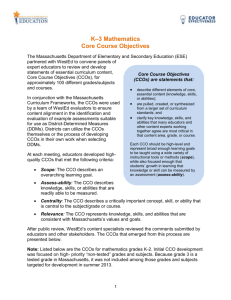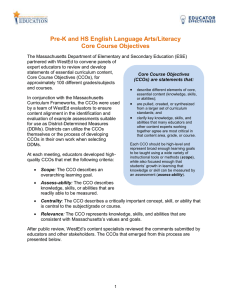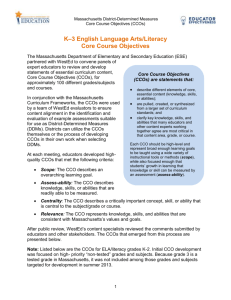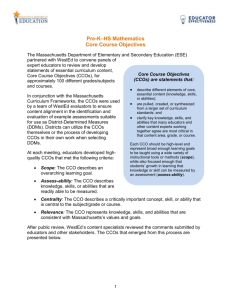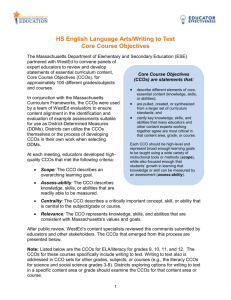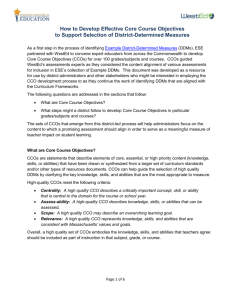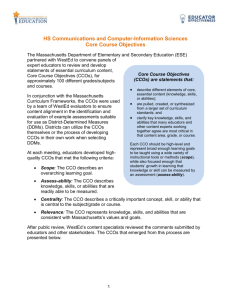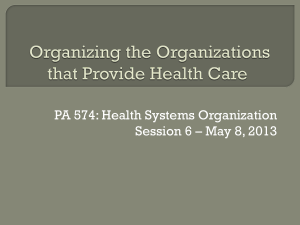Core Course Objectives - Massachusetts Department of Education
advertisement
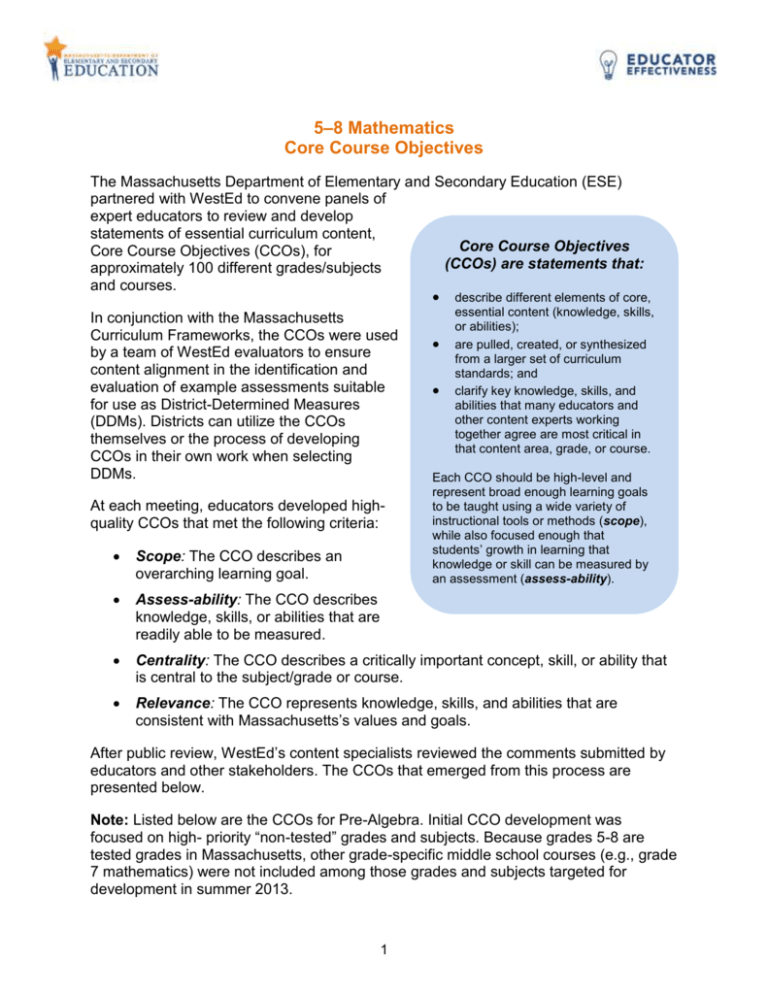
5–8 Mathematics Core Course Objectives The Massachusetts Department of Elementary and Secondary Education (ESE) partnered with WestEd to convene panels of expert educators to review and develop statements of essential curriculum content, Core Course Objectives Core Course Objectives (CCOs), for (CCOs) are statements that: approximately 100 different grades/subjects and courses. describe different elements of core, essential content (knowledge, skills, In conjunction with the Massachusetts or abilities); Curriculum Frameworks, the CCOs were used are pulled, created, or synthesized by a team of WestEd evaluators to ensure from a larger set of curriculum content alignment in the identification and standards; and evaluation of example assessments suitable clarify key knowledge, skills, and for use as District-Determined Measures abilities that many educators and other content experts working (DDMs). Districts can utilize the CCOs together agree are most critical in themselves or the process of developing that content area, grade, or course. CCOs in their own work when selecting DDMs. Each CCO should be high-level and At each meeting, educators developed highquality CCOs that met the following criteria: represent broad enough learning goals to be taught using a wide variety of instructional tools or methods (scope), while also focused enough that students’ growth in learning that knowledge or skill can be measured by an assessment (assess-ability). Scope: The CCO describes an overarching learning goal. Assess-ability: The CCO describes knowledge, skills, or abilities that are readily able to be measured. Centrality: The CCO describes a critically important concept, skill, or ability that is central to the subject/grade or course. Relevance: The CCO represents knowledge, skills, and abilities that are consistent with Massachusetts’s values and goals. After public review, WestEd’s content specialists reviewed the comments submitted by educators and other stakeholders. The CCOs that emerged from this process are presented below. Note: Listed below are the CCOs for Pre-Algebra. Initial CCO development was focused on high- priority “non-tested” grades and subjects. Because grades 5-8 are tested grades in Massachusetts, other grade-specific middle school courses (e.g., grade 7 mathematics) were not included among those grades and subjects targeted for development in summer 2013. 1 Massachusetts District-Determined Measures Core Course Objectives (CCOs) Mathematics/Pre-Algebra – Grade: 8 # Objective 1 Students solve problems involving scale factors, rates, and derived measures (e.g., density). 2 Students represent and compute unit rates by modeling, solving, and explaining real-world problems. 3 Students model rational numbers, distinguish rational numbers from irrational numbers, represent each on the number line, and recognize that together the rational numbers and the irrational numbers form the real number system. 4 Students solve real-world problems involving the four operations with rational numbers. 5 Students write and interpret mathematical expressions, equations, and inequalities in context. 6 Students evaluate expressions and use expressions, linear equations (including pairs of simultaneous linear equations), and inequalities to solve problems. 7 Students recognize that a function is a rule that assigns to each input exactly one output. 8 Students determine the slope and y-intercept of a linear function described by a symbolic expression, table, or graph, and interpret the slope and y-intercept of the graph of a linear function representing a contextual situation. 9 Students represent and explain the effect of one or more translations, rotations, reflections, or dilations (centered at the origin) of a geometric figure on the coordinate plane. 10 Students apply the Pythagorean Theorem to determine measures in context. 11 Students explore and explain angle relationships; identify pairs of angles as complementary, supplementary, adjacent, or vertical, and determine missing angle measures using these relationships; and use informal arguments to establish facts about angles. 12 Students solve real-world area, surface area, and volume problems using different strategies (formulas and decomposing figures.) 2 Massachusetts District-Determined Measures Core Course Objectives (CCOs) # Objective 13 Students describe data sets using measures of center and variability; and they summarize and compare two unequal distributions of data using number of data points, measures of center, shape, and variability (numerical data), and two-way tables (categorical variables). 14 Students identify, design, and conduct multi-stage (compound) probability experiments (independent events) and compare the results with theoretical probabilities. Note: These Core Course Objectives were developed by Massachusetts educators in summer 2013. They are intended to provide districts with information about the content taught in this course. Source documents used are as follows: Massachusetts Mathematics Curriculum Framework (2011); Learning Progressions Frameworks Designed for Use with The Common Core State Standards in Mathematics K–12 (NCIEA) (2011); Pre-Algebra Power Standards, Auburn School District #408 (Washington 2011). 3
